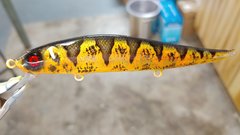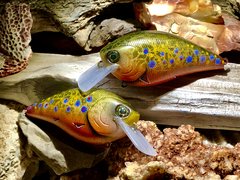-
Posts
906 -
Joined
-
Last visited
-
Days Won
45
Content Type
Profiles
Articles
TU Classifieds
Glossary
Website Links
Forums
Gallery
Store
Everything posted by Chuck Young
-
What size tip do you use? And what size glitter?
-
You can sand in between coats of fully cured epoxy. That will get rid of the high points and it will come out really smooth. As for challenges to your manhood, we all find lure gold wherever we can. Just don't appear on camera in your unicorn T shirt and all is well.
-
Cheaper to buy a white dog, me thinks.
-

Replacement feathered treble hooks for Rapala XR04
Chuck Young replied to Patton70's topic in Hard Baits
Feathers are incredibly durable, if tied correctly. I have flies that I have tied from feathers that have lasted 100's of fish and many, many years. A feather may look delicate, but it is very tough. You just need to find the ones with the right qualities. A flexible stem, high barb count, and proper stiffness are very desirable qualities . But the fibers themselves are all made of the same stuff. Synthetic fibers are also very useful. It can be hard to find ones that flow the same way feathers do. But synthetics have their own qualities. They are stiffer, retain their shape, and do not flair. Choose what is right for the job. -
Monte, be careful with that spell check.
-
1) Denatured alcohol also be used to clean blanks - it smells better. 2) An airbrush gives you much better control than a rattle can. You can remove most or even all of your scale detail if you are not careful. Cleaning an airbrush between coats can be a s simple as running a little water through it. I currently use a bottom feed, so touch the bottle, remove, empty, repeat. Finally spray it dry while shaking it. It takes seconds. If I feel there is a clog, I back-flush. I am looking to add a second (top feed) brush for more detail. Both will be hooked up and available. My plan on cleaning the top feed it to clean out the cup by spraying water from the first brush into the cup and chasing the paint out of it. Then spraying water through the brush itself. 3) Avoid getting it in the eyes (too much topcoat or not rotating a lure can cause this). You have to seal by the eyes, but use care and remove the excess. A wider brush will apply topcoat more evenly. It can be cleaned with denatured alcohol and wrapped in a paper towel for reuse. The wire thing works great while the epoxy has not set. A toothpick works well also. Mechanically removing set epoxy has to be done with care. Too much pressure can split some low quality blanks.
-
Doing some ice fishing?
-
I haven't used KBS. But with epoxy, you can sprinkle fine glitter on the first coat (using a salt shaker type container) while it is still wet. Re-dipping will seal and smooth it. Glitter alone is much cheaper than nail polish. Problems can occur when you use too many different mediums on a lure.
-
If you are not opposed to using a toothbrush, the spatter-back is a simple and effective pattern. Mine was done with an airbrush, but toothbrush works fine. .008 glitter(silver holographic nail art powder) is mixed with epoxy. http://www.tackleunderground.com/community/gallery/image/18305-spatterback-white-diamonds1jpg/
-
Try wiping with DNA, sanding it a little with fine paper. Give it some tooth.
-

Replacement feathered treble hooks for Rapala XR04
Chuck Young replied to Patton70's topic in Hard Baits
These look like saddle hackle feathers wrapped then tied back a little. Stay away from the webby feathers. They stick together because they are designed like zippers. When a bird preens its feathers, they are zipping them back together. . Look for a thin stem or they will be too bulky and fragile. Or you could buy some strung saddle hackle. Some flat tying thread will make your head nicer. Acetate floss can be used to finish the head. Wrap it and apply a drop of acetone - it turns into solid plastic. -
There is probably no way to tell. Most who sell blanks need to reach a certain order quantity before they are able to restock.
-

Color changing paint. Color Shifting paint, powder pearls. Paint
Chuck Young replied to Kreate's topic in Hard Baits
The future and pledge and other floor care products are a hard acrylic. I am a former floor care professional. I owned my own floor care business. Think about the qualities you need in a floor care product. Here in New England we have harsh winters and a lot of salt / sand applied in parking lots. That is what floor finishes are designed to withstand. Imagine what it takes to remove that product from your airbrush. Not all acrylics are the same. I choose not to put that stuff into a close tolerance airbrush. -

Color changing paint. Color Shifting paint, powder pearls. Paint
Chuck Young replied to Kreate's topic in Hard Baits
I want to go on record that I have had major problems with the windex - future - water combinations. I mixed up some homemade reducer involving glycerin, distilled water, and amonia free windex. At the same time I bought some brand name reducer (createx). It worked so flawlessly that I never used the home-made concoction. I am still using my first 8 oz bottle of 4012. And I wouldn't dream of using the home-made mix. I estimate the cost per bait at less than 2 cents. -

Color changing paint. Color Shifting paint, powder pearls. Paint
Chuck Young replied to Kreate's topic in Hard Baits
Color shifting is a very attractive quality in a bait. I feel it touches more "trigger points". It occurs naturally in baitfish. The more 3-D the finish on your bait, the more effective the color shift will be. Certain foils can also be applied to accomplish a color shift. I think I am with Hughsey on this one. If you want color shifting qualities - go all out. The per bait cost is a few cents . -
I have used the same technique on balsa airplanes for anchoring the wing bolts. . But I had to use a tap to cut the threads between each application of CA. With balsa, CA may penetrate better. But with harder woods, drilling the entire length of the screw eye and using epoxy (which probably fills gaps better than runny superglue) will keep you from splitting the wood. This is cat skinning territory - but it also varies from situation to situation.
-
Personally, I would shy away from CA. Epoxies give you a longer working time. Imagine having the superglue set before the screw gets all the way in. That would not be good. Those look great by the way. With some woods, you have to worry about the screws splitting the wood. With epoxy, you can drill all the way. It will fill the gaps and soak into the wood. This technique also allows for the perfect alignment of screws .
-
I use a posterboard form (the one made of foam sandwiched in cardboard) 1/2 or slightly more the thickness of the lure. craft foam (kid's section of Michaels) can be added if the lure blank is too thick. Here is a link. I hope it helps. These don't lock up or damage your paint. Save both the form and the stencil as they can be used over and over. http://www.tackleunderground.com/community/topic/31562-vacuform-machine-for-clam-shell-style-stencils/?tab=comments#comment-256756
-

Color changing paint. Color Shifting paint, powder pearls. Paint
Chuck Young replied to Kreate's topic in Hard Baits
Faskolor also has some color shifting paints (blue, violet and red). Check out modeling suppliers. -

Color changing paint. Color Shifting paint, powder pearls. Paint
Chuck Young replied to Kreate's topic in Hard Baits
Hope you have a lot of reducer for acryilic paint. You will need it. Createx reducer works. Also use the coarsest needle / head set you have. It still won't spray right. -
If it's lumpy .... dumpy. The smallest of clots will mess up your brush. It is not worth the trouble. Get rid of it .
-
A moisture cure urethane gives you a much thinner coat than epoxy, and a much more durable coat than laquer. It should not interfere with the action of your blades. So make that 3X
-
-

C3F9A3A4-0ED0-4438-BAC1-9556CF8ADB49.jpeg
Chuck Young commented on Jekyll424's gallery image in Hard Baits
-
I think this would make a nice informal contest. Everybody who has the equipment can post a pic like this. Then we can vote at the end of the year. No prizes, just fun.







